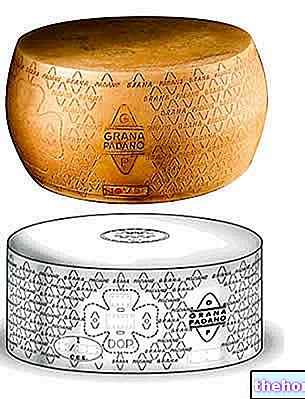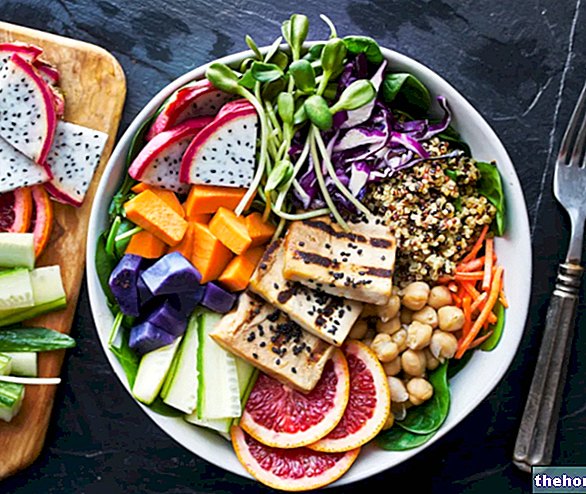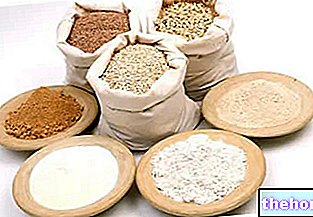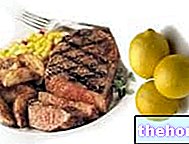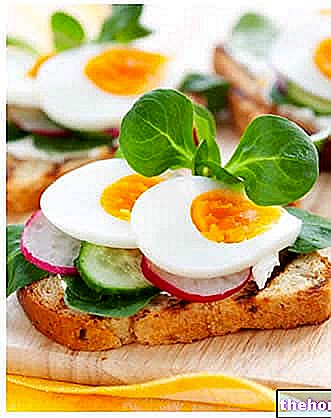Foods rich in fats or lipids are all those foods which, from a chemical and nutritional point of view, are distinguished by their high intake of triglycerides and / or cholesterol.

Triglycerides and cholesterol
Fats are substances soluble in organic solvents and not very soluble in water; it is difficult to define the functional unit of fats, as they represent a fairly heterogeneous group of molecules that are all different.
Classification of the main fats
Containing glycerol: Neutral fats (monoglycerides, di-glycerides and triacylglycerols or triglycerides), glycerol ethers (glycosylglycerides and phosphoglycerides; phosphatides; phosphatidylglycerols; phosphoinositides)
NOT containing glycerol: Sphingolipids (ceramides; sphingomyeline; glycosphingolipids), aliphatic alcohols and waxes, terpenes and steroids (cholesterol), fatty acids
- Triglycerides: triglycerides or triacylglycerols are neutral lipids containing fatty acids linked to a glycerol molecule; in nutrition they provide 9 kcal per gram and represent about 25-30% of the energy ration. Their composition in fatty acids represents a characteristic element between a good and a bad diet; in fact, the fatty acids that compose them are usually different from each other (even if on average they contain 16-18 more or less saturated carbon atoms) and their nature distinguishes their peculiarities as well as their nutritional impact.
- Cholesterol: cholesterol is the most abundant steroid in the body and is NOT essential as about 70% of the total comes from endogenous Acetyl-CoA. It is a fundamental substrate for the synthesis of steroid hormones and vitamin D, moreover, it represents a structural element of cell membranes; the only way of elimination of cholesterol is the faeces, in which it is poured out through the bile salts (compounds responsible for the digestion of dietary lipids).
- Essential components: among the lipid molecules there are also nutrients called essential, or that the body is not able to produce independently. Among these we remember the polyunsaturated fatty acids of the omega3 and omega6 series, and the LIPOsoluble vitamins: A, D, E, K.
Distinction of foods rich in fat
Among the foods rich in fat, a distinction can be made between those rich in triglycerides only, those rich in triglycerides and cholesterol, and those containing significant amounts of cholesterol but proportionally not as rich in triglycerides.
Foods rich in triglycerides
Foods rich in triglycerides alone are mainly vegetable seasoning oils. This category of food is distinguished by a contribution of triglycerides equal to 99.9% of the total weight and only traces of water. They respectively provide 899kcal per 100g of edible portion but their qualitative composition can vary considerably according to the extraction food.
The oils differ from each other for the nature of the fatty acids contained which, as anticipated, determines their chemical-physical characteristics useful in the various food preparations. For example, oils rich in monounsaturated and saturated fatty acids (hydrogenated or not) but poor in polyunsaturated fatty acids are much more suitable for frying, as they have a rather high smoke point (PF). This is the case of palm oil (PF 240 ° C) but also of "extra virgin olive oil (PF 210 ° C), the latter being limitedly used in frying due to the decidedly higher costs compared to tropical extracts or The same is true for the oils useful for the preservation of food in oil; even in this case, the content of polyunsaturated fatty acids plays to the disadvantage of the food process: since these nutrients are easily peroxidized, they would negatively contribute to the preservation of the product, facilitating its rancidity (lipid peroxidation). grape seeds, soy or sunflower seeds, while the extra virgin olive oil (also rich in natural antioxidants: vitamin E and polyphenols) stands out once again for its high healthiness even in frequent use. On the other hand, in use. raw it is possible to range over many products deriving from numerous raw materials, the important thing is that the oil in question is obtained through COLD PRESSING (such as extra virgin olive oil, soy, flax, etc.); this is an absolutely fundamental requirement, as the main nutritional characteristic of the seasoning oil is the supply of essential fatty acids (omega6 and omega3 family) which, being easily thermolabile, could deteriorate following the extraction process (squeezing at hot).
There are also other foods rich in triglycerides but free of cholesterol; among these we remember:
- The olive, a fruit from which oil can be extracted
- Avocado, an exotic fruit with a very high SATURATED lipid content
- Coconut, an exotic fruit with a very high lipid content of medium-chain fatty acids (similar to those of breast milk), from which it is possible to extract the oil
- The peanut, a "toasted" legume from which oil can be extracted
- Some achenes better known as dried fruit: walnuts, almonds, hazelnuts, pecans etc.
As already stated, foods rich in triglycerides only are typically of vegetable origin and their importance in the diet varies according to the specific product and its characteristics, or rather according to the type of fatty acids that compose them. We also remind you that among all the foods mentioned above, there are NO products that are actually rich in eicosapentaenoic acid (essential fatty acid of the omega3 category - EPA), which is instead very present in various foods of animal origin.
Foods rich in triglycerides and cholesterol
Foods rich in triglycerides and cholesterol are products of animal origin; it should be emphasized that, except for some particular cases, these are also characterized by saturated fatty acids, therefore typically hyper-cholesterol-lowering and potentially harmful to the cardiovascular system.
Foods rich in fat, especially triglycerides and cholesterol, are ESPECIALLY:
- Some offal or components of the fifth-fourth: among these we can distinguish the brain (also rich in essential fatty acids and phospholipids) and the liver.
- Cream, mascarpone and aged cheeses (all): obviously, there is a certain variability in the total fat content that depends on the raw material of cheese making: goat, buffalo, sheep or cow's milk, whole, skimmed or partially skimmed. Some examples of aged cheeses are: Parmigiano Reggiano, Grana Padano, Pecorino (all), Emmenthal, Edamer, whole milk provole etc.
- Butter, lard, lard, lard, tallow and rind.
- White meat WITH SKIN: in itself white meat is recommended in the diet of the "hypercholesterolemic as it is distinguished by an" excellent "thinness"; the situation is reversed if it is consumed WITH SKIN, which contains very high portions of both cholesterol and triglycerides.
- Fatty meats, stuffed and salted but NOT DEGREASED: all. From bacon to sausage; from ribs to mortadella.
- Some fish and all the eggs of fishery products: some examples are the eel (with the due differences related to the origin, size and season of capture), the tuna belly (although very rich in EPA and low in saturated fatty acids ), large specimens of salmon (although very rich in EPA and low in saturated fatty acids), caviar, lumpfish roe, bottarga, sea urchins, flying fish roe (widely used in the preparation of raw Japanese food). NB. The skin of fish, like that of white meat, contributes to significantly raise the levels of total fat introduced with the diet.
- Egg yolk: heavily used in pastry preparations such as custard, custard, etc.
Foods rich in cholesterol but low in triglycerides
Surprisingly, some fishery derivatives fall into this category; for those who do not know, it is correct to say that the population does NOT consume sufficient fish (especially blue fish), but molluscs and crustaceans which, on the contrary, are widely consumed globally, DO NOT fall into this category. BIVALVI molluscs and crustaceans are distinguished by a notable contribution of cholesterol in relation to a content of triglycerides that is not excessive; in particular we mention:
- Mussels and oysters: especially during the reproduction phase, these organisms modify their cholesterol content to comply with the hormonal cycle of fertilization
- Shrimps, crabs and all derivatives: including crab meat, crab claws (fried), surimi, shrimp tails, peeled shrimps, etc.
NB. In the list, ONLY foods rich in fats were mentioned whose nutritional values are known; however, it can be deduced that other "similar" products belonging to the same category / genus (such as scampi with respect to the crustaceans mentioned in the last paragraph) they can boast the same chemical-nutritional characteristics and therefore must be treated as such.
Bibliography:
- The molecular basis of nutrition - G. Arienti - Piccin - page 131
- Recommended Nutrient Intake Levels for the Italian Population (LARN ) - Italian Society of Human Nutrition (SINU)

